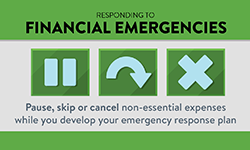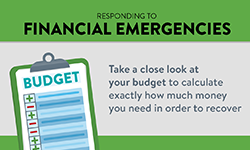An emergency savings fund is a crucial part of your personal finances. No matter your greater financial goals—eliminating debt, improving your credit score, saving for your kids' college, saving for retirement—building a sufficient emergency savings fund is the first step to a financial healthier, wealthier you.
Your emergency fund is the life preserver you keep in case of a financial emergency; it keeps you afloat, so you don’t drown in unexpected bills. A surprise vet bill, an urgent trip to the hospital, an unavoidable car repair—all of these can quickly derail your life and force you to rack up high-interest credit card debt or miss other bill payments if you don't have an emergency fund.
So how big does your financial life preserver need to be? The first step, no matter what your life circumstances, is to save up one month's worth of take-home pay, i.e. the amount after taxes are deducted. Once you have this amount in your emergency savings account, you can focus on growing it to your personal savings target while also tackling other goals.
Those general saving targets are often called the "3-6-9 rule": savings of 3, 6, or 9 months of take-home pay. Here are some guidelines to help you decide what total savings fits your needs.

3 Months
Three months of take-home pay is a good emergency fund target if you:
- are currently a renter
- do not have dependents (i.e. children)
- have a steady paycheck
- have a reliable "safety net"
A "safety net" includes friends and family who could give you a place to live, a car to drive, part-time work, or some other form of help if your situation turned dire.
Of course, you could match the above description perfectly and decide to save up more than three months' income. If you do, you'll be less reliant on your "safety net" should something stop or hinder your stream of income.
6 Months
This savings target applies to the largest group of people and is probably the most commonly quoted emergency fund goal. Six months of take-home pay should be safely tucked in your savings if:
- you have kids
- you have a mortgage
- your household has two steady paychecks
Any combination of these qualifies you to join this group of savers. Single with kids and renting? Shoot to save six months' income. Married and live in a condo? Still six months.
If your household has two steady incomes, you should aim to build your emergency fund equivalent to six months of take-home pay of the highest earner. Want to be doubly safe? Calculate six months' income based on both incomes and sock it away.
9 Months
If saving six months' worth of paychecks sounds intimidating to most people, nine months may sound ludicrous. But there are situations when this is the ideal amount of money to have in case of a rainy day...or a few rainy months back to back.
If you and/or your significant other are self-employed or work freelance full time, you belong in this group. When your income is unpredictable, the bigger impact an unexpected bill can have on your life. A larger emergency fund not only helps protect your family from feeling the pinch of slow business or an unexpected bill, but it also helps protect your career. Without a sufficient emergency fund, a few slow months of work may force you to switch careers and return to a 9-5 job.
The "3-6-9" guidelines for emergency savings can be helpful and give you peace of mind when building your emergency fund. But, remember, they're guidelines and not hard rules. If your gut says you need 4, 7, or 10 months saved up based on your income, expenses, and past experience, go for it.
Start Your Emergency Savings Fund
With an emergency savings account, you can cover costs you didn't expect to have. Pay for car maintenance, medical bills, home repairs, and other unexpected expenses. Stop by a branch to open your Emergency Savings Fund today.
RESOURCES
« Return to "Blog"




